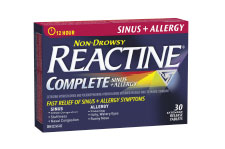Same Brand Name, Different Ingredients
2015-02-12 (Revised 2015-03-19)
Have you ever gone to the store to buy your favourite brand of laundry detergent, only to get home and realize that what you bought isn't exactly what you wanted? The brand name is the same, and the packaging is similar to the detergent you usually buy, but once you look more closely, you realize that it contains bleach, or maybe it is only suitable for a high-efficiency machine. Mistakes like this can happen just as easily when you are buying nonprescription medicines.
Well-known brand names are often used for a range of products that contain different medicinal ingredients. This practice of extending a product line under a single brand name is sometimes called brand-name extension or using an umbrella name. Umbrella names are commonly used for self-selection products that are used to treat cough and cold symptoms, fever or pain, and allergies.
SafeMedicationUse.ca has received two reports of cases where umbrella names led consumers to buy a different product from what they intended to buy. In the first report, a consumer wanted to buy Reactine Regular Strength for allergy control. She bought a package containing Reactine products at a local big-box store. The consumer's son, who uses the same allergy product, opened the package when she returned home and realized that a mistake had happened. The consumer had purchased a package containing Reactine Allergy + Sinus and Reactine Extra Strength, thinking that she was purchasing Reactine Regular Strength.
The consumer and her son compared the labels of the products she had purchased with the label on a package of Reactine Allergy regular strength. The main panel of each box said "Reactine Allergy", but the narrow band at the top of each box was a different colour and carried a different label. The consumer was happy her son had noticed the products were different, but she was concerned the similar packaging of Reactine products could cause confusion for others.

(Image courtesy of Johnson and Johnson Inc.)
 - (Image courtesy of Johnson and Johnson Inc.)
Johnson and Johnson has advised us that the label of the Reactine Allergy and Sinus product has recently been changed, and it is now branded as REACTINE COMPLETE Sinus and Allergy, as shown to the right. This change may help consumers differentiate Reactine Complete Sinus and Allergy from the other products in the Reactine line.
A second report involved an elderly consumer who wanted a cough syrup to ease the symptoms of a bad cough. The consumer was taking a number of other medicines. Her family thought it would be best to avoid products containing the cough suppressant dextromethorphan, because of possible drug interactions.
A caregiver bought a bottle of Robitussin Cough Control for the consumer, not realizing that it contained dextromethorphan. Previously, this product was called Robitussin DM. The consumer took a few doses of the cough syrup before noticing that it contained dextromethorphan. She did not suffer any ill effects, but her family was concerned about confusion with different Robitussin products.
Confused at the Over-the-Counter Products Aisle??
The International Medication Safety Network (IMSN) has raised concerns about the use of umbrella names. The IMSN is a group that promotes safer medication practices around the world. At a global meeting last year, the IMSN discussed safety issues related to the labelling and packaging of medicines. Group members noted that the use of umbrella names for medicines containing different ingredients can be confusing for consumers and also for healthcare professionals. This practice can also lead to errors. The IMSN recommends that rules be created for the use of umbrella names with a greater focus on patient safety, rather than favouring commercial interests.
Consumers should be cautious when choosing from a range of medicines and other health products under one brand name. Here are some tips:
-
Read labels carefully. Look for differences between product labels with the same brand name to make sure you choose the product that is right for you.
-
Check the medicinal ingredients and how much of each ingredient is provided in the medicine.
-
Read the dosing instructions. Recommended doses can vary among different products, especially if they contain different strengths of a medicine.
-
Ask your pharmacist for advice if you are not sure which medicine is the best one for you.
Read more about Brand Name Extensions.
Reference: Making medicines naming, labeling and packaging safer [position statement]. Horsham (PA): International Medications Safety Network; 2013 [cited 2014 Dec 10]. Available from: www.intmedsafe.net/wp-content/uploads/2014/07/Making-Medicines-Naming-Labeling-and-Packaging-Safer-Final-A4-2013.pdf
|

